How many battles do we know of the Second Punic War? The most famous, without a doubt, are those of Cannae, Trebia, Zama and Lake Trasimeno, all of them carried out, on the Carthaginian side, by Hannibal Barca. But there were many more - not in vain were seventeen long years of conflict - and some not only did not have the participation of the most distinguished of the Barca but were also decisive for the final result. For example, that of Metauro, where the Punic forces were led by his brother Asdrúbal. And they suffered a heavy defeat.
If not much is known about Hannibal's childhood, Asdrúbal's is also partially unknown, except that both had to escape in a hurry from the ambush that the Iberians set for his father Amílcar in Akra Leuke (near Alicante).
It was there precisely where they became orphans, because his mother drowned crossing the Vinalopó River. In any case, both had been trained in the art of war and when Hannibal began his Italian campaign in 218 BC. he left Asdrúbal covering the Spanish rearguard.
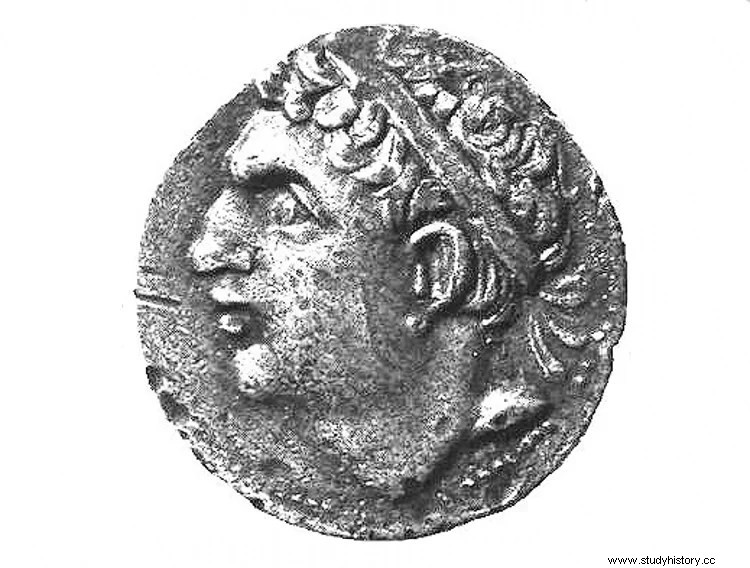
For this he had a considerable army of almost 13,000 infantry, 2,550 horsemen and 21 elephants that had to join another contingent established north of the Ebro, under the command of Hannón (of whom it is unknown if he was a third brother, a nephew or a soldier without kinship with them), formed by 10,000 infantrymen and a thousand cavalry (apart from a powerful fleet of fifty quinqueremes and five triremes).
The plan was to march together in support of Hannibal but the Romans were aware of their intentions and set out to stop them. Interestingly, they were also led by a couple of brothers:Gnaeus Cornelius Scipio Calvo and Publius Cornelius Scipio.
Their idea was to fight the Carthaginians separately, before Hasdrubal could link up with Hanno, so the proconsul Gnaeus Cornelius jumped on him at Cissa, a supply base near Tarraco (although some historians consider that they were the same city).
He had twice as many troops (two Roman legions and two other allies) plus the support of the local towns, so he was fairly easily victorious; even Hanno was captured. It was a catastrophe for the Punics, who lost control of the northeast region of the Iberian Peninsula as well as reinforcements and supplies for Hannibal.
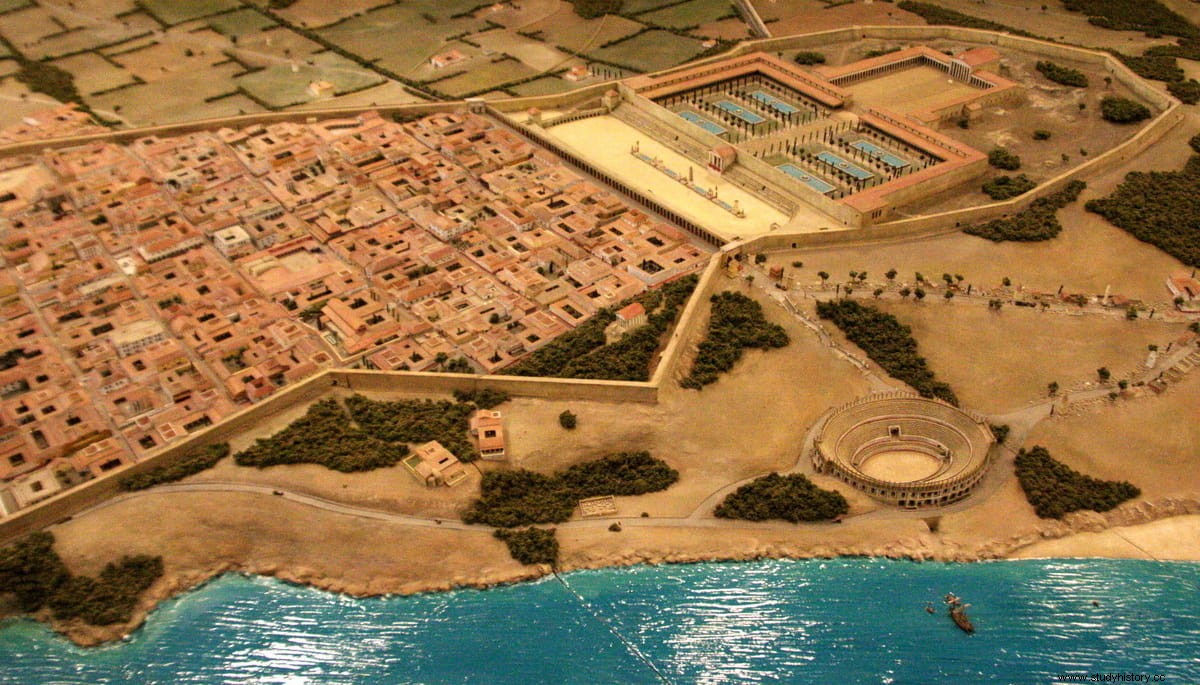
Hasdrubal arrived when everything was over and although he crossed the Ebro and had time to harass the Roman rearguard, destroying half of his fleet, the arrival of aid from Massilia (Marseille) and the hostility of the tribes in the area forced him to return to Qart Hadasht (Cartagena). In contrast, Gneo Cornelio established a base in Emporion (Ampurias), which gave him time and peace of mind to plan his campaign, negotiating alliances with the Hispanics.
Hostilities resumed the following year, although the initiative fell to Hasdrubal. His plan of parallel advance, by land but supported by his fleet, failed when it was surprised by Roman ships at the mouth of the Ebro. Without naval support, Hannibal's brother had to withdraw again and, while waiting for reinforcements, dedicated himself to to repress the uprising of the people from Turdeta around Gadir (Cádiz). Those reinforcements, 4,000 infantry and 400 horsemen, arrived accompanied by an express order from the Senate of Carthage:to go to Italy to help his brother.
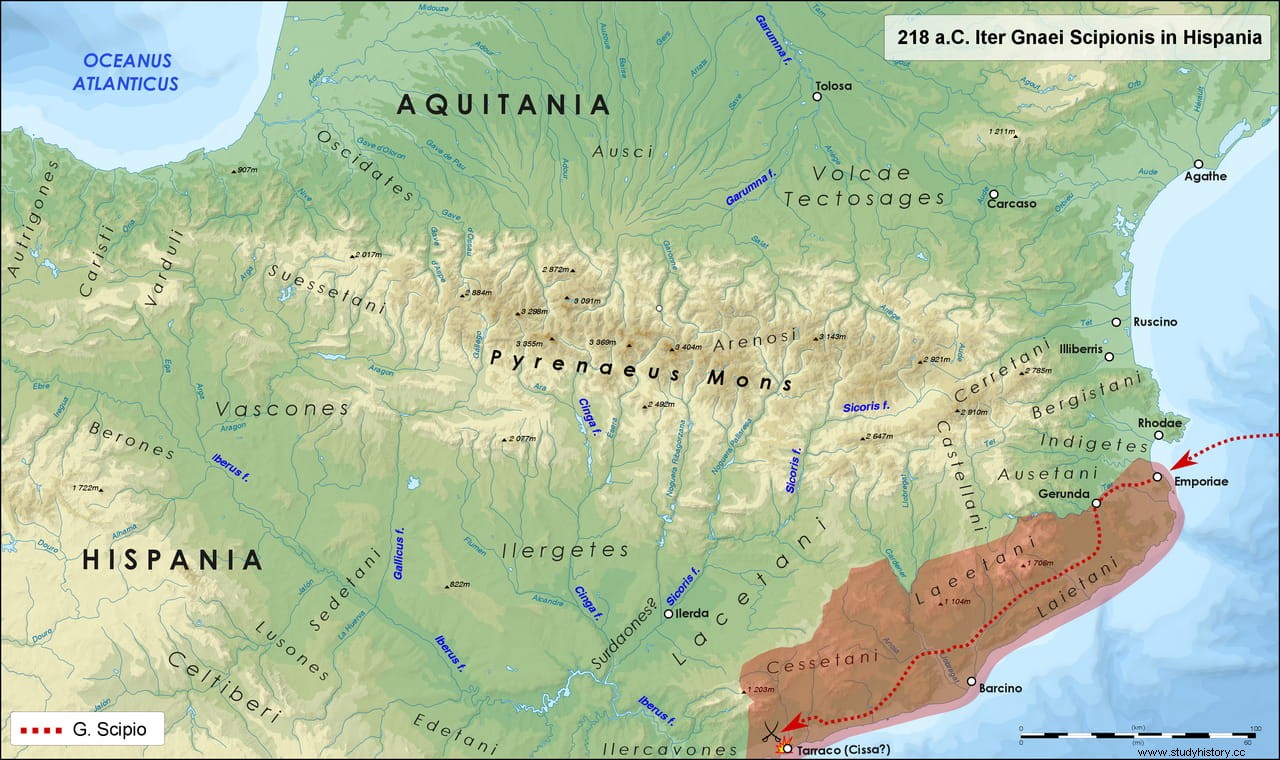
It was not easy because along the way he suffered a defeat against Gnaeus and Publius Cornelius in Dertosa (near Tortosa), in 215 BC, because the troops with which he tried to reproduce Hannibal's tactics in Cannae were inexperienced and did not have or with good officers and not enough cavalry (aside from the fact that the two Scipios were far superior to Terence Varro, the Roman general at Cannae).
Thus, Asdrúbal could not comply with the order of the Senate and he sent his brother Magón and Asdrúbal Giscón to relieve him, although the underlying objective was to end the domination of the Barca in the Iberian Peninsula.
The Romans managed to entertain the Carthaginians there while they extended the war to North Africa, by convincing King Siphax of Numidia to ally with them.

But the monarch was defeated by Asdrúbal, who joined three thousand Numidian horsemen to his army and returned to Iberia. Collaborating with his namesake and his Magón, he prevailed over the enemy in the battle called Betis Superior , where the two Scipios lost their lives. This made it possible to recover the northern part of the Ebro, although the Romans were still entrenched there with a third Scipio in command, Africanus, son of Publius Cornelius.
Scipio managed to restore the spirits of the legions and defeated Hasdrubal at Baecula in 208 BC, as well as recapturing Qart Hadasht (renamed Carthage Nova). But Hannibal's brother was able to save two-thirds of his troops, which, augmented by those of his namesake and Mago, plus the recruitment of Iberian mercenaries, gave him a powerful army to resume the path of Italy once again, that same year. In Gaul he incorporated still more men, crossing the Alps faster than his brother had done years before - the path was still open; so much, in fact, that he barely had time to break his camp to meet him.
Hasdrubal was reinforced with Ligurians and thus reached the Po Valley, heading towards the Adriatic. Along the way he failed in the attempt to conquer Placentia (Piacenza) but still constituted an obvious danger. Alarmed, the Senate of Rome commissioned the formation of two new consular armies, since the consuls Gaius Claudius Nero and Marco Livio Salinátor had just been elected. The first received the mission of confronting Hannibal, which he avoided due to his numerical inferiority, spending a year playing cat and mouse for Brutium (Calabria). Salinator was tasked with dealing with Hasdrubal but he too did not seek a direct clash.

In this way, Asdrúbal crossed the river Metauro and reached the port of Senigallia, sending messengers to Hannibal to meet in the region of Umbria. Those couriers were intercepted by the Roman praetor of Gaul, Lucius Porcio Licinus, who followed the column harassing it but, equally, without entering into open battle. The possibility of the Carthaginian brothers uniting was a huge risk, so the two consuls decided to unite their forces in the north and also join Licinus' forces to confront Hasdrubal, a priori an easier rival than his brother.
Forcing 7,000 chosen men to go on forced marches, Nero traveled 400 kilometers in a week, according to the chronicles of the time («Unmatched march in military annals» , defined Lord Byron). Faced with this enormous force that camped before him, Hasdrubal mobilized his army at night with the idea of returning to Gaul, where he would be safer.
But between the defection of the guides and the darkness of the night, he was not able to find a ford through which to cross the Metaurus and the sunrise surprised him disorganized; his Gallic mercenaries were even drunk. As the Roman cavalry was coming towards his position, he was left with no choice but to fight reluctantly.
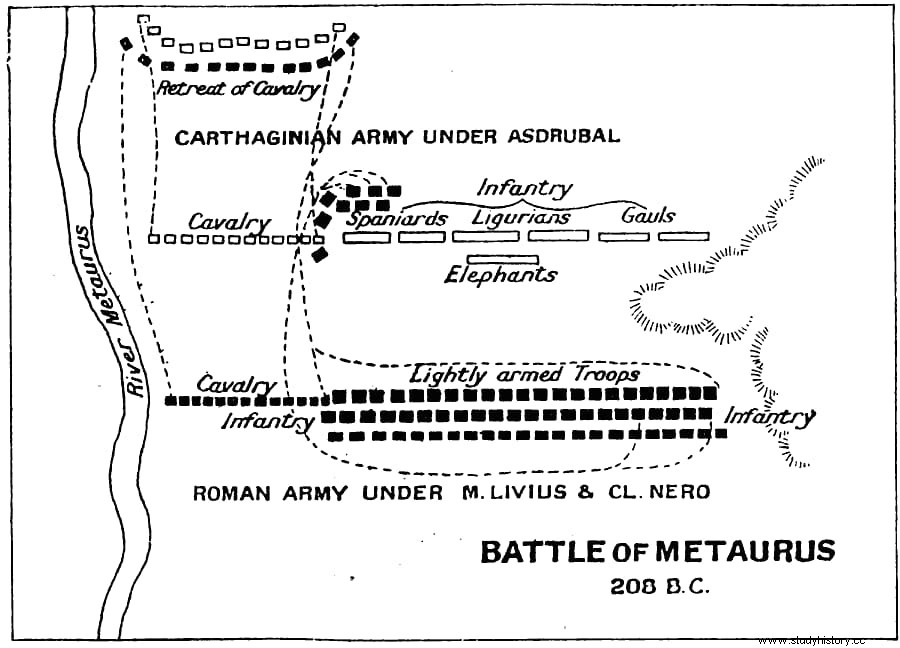
The data on the number of contenders differs quite a bit from one author to another. Appian speaks of 48,000 Carthaginian infantrymen, 8,000 horsemen, and 15 elephants; Tito Livio fires the figures saying that 61,400 prisoners were made and that many more were able to escape; Polybius, on the other hand, reduces the Punic and Gallic dead to 10,000. Current estimates place between 20,000 and 48,000 men. On the Roman side, there was the consular army of Salinátor plus the two legions of Licino and the 6,000 legionnaires and 1,000 horsemen of Nero, so the total would be around 37,000 troops.
The Carthaginian army formed in line with the Ligurians in the center, behind the ten remaining elephants; the cavalry was placed on the right flank -next to the river- to prevent the Roman horsemen deployed in front from encircling them. She was accompanied by the best soldiers, the Iberian veterans, leaving the entire wing under his direct command. On the left the Gauls were deployed, half covered by a hill. Opposite, Salinátor assumed command of the left flank, leaving Nero the right and Licinius the center.
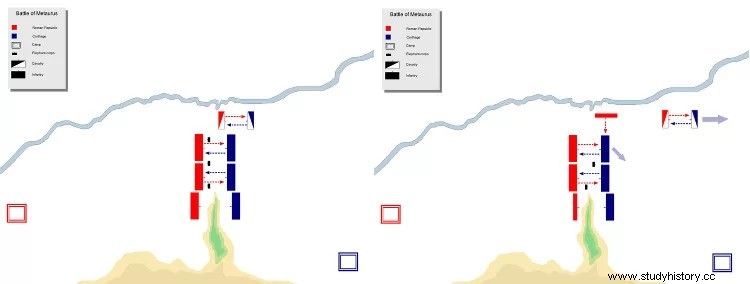
The battle began with Salinátor charging the enemy to take advantage of the numerical superiority of the cavalry, but the Punics resisted and counterattacked with the elephants, breaking the Roman lines and sowing chaos until something quite frequent happened:the frightened pachyderms gave half turned around and threatened their own, for which six ended up slaughtered at the hands of their own mahouts . The rest would end up captured at the end of the clash.
Meanwhile, Nero had a fit of genius:refusing to attack the Gauls, too well protected by the terrain, he left a contingent to hold them there and took half his people in cohorts to the left flank. This tidal wave of troops penetrated the flank as it was no longer protected by the cavalry and sank the Iberian line, which began to retreat, dragging the Ligurians from the center.
The formation broken and with the cavalry on the run, the battle was lost. Hasdrubal tried to reorganize his soldiers to make a desperate counterattack, perhaps thinking that there was no possibility of fleeing being boxed in between the riverbed and the hill; he died trying.
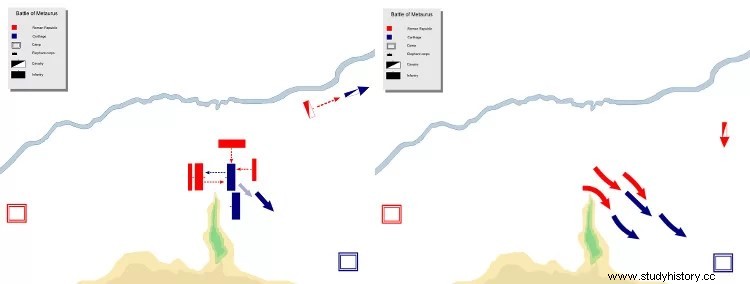
Polybius estimates that they suffered tens of thousands of casualties for two thousand of the Romans. Livio, as we have seen, increases the figures to 56,000 dead and 5,400 Carthaginian prisoners. For their part, the Gauls barely had a chance to intervene and managed to escape, joining the surviving Ligurians to form a force of 10,000 men, which shows that Hasdrubal perhaps He was wrong and he had alternatives. In any case, since he had died, that troop lacked a leader and ended up disbanding. Another possible mistake since an officer named Hamilcar would still form another army in Cisalpine Gaul (it is true that this would be in 200 BC) and Mago would arrive in 205 BC. with more reinforcements.
Both Nero and Salinátor were awarded with a triumph through the streets of Rome, although the first could only go on horseback while the second focused the honors on a chariot; however, it was popularly said that the true architect of victory was the one who was mounted. Quoting Lord Byron again, the English poet ironically about the fact that the Nero who went down in history was the emperor while he lamented: "Who thinks of the consul?"
The Romans had once again saved a difficult situation and, proudly, they let Hannibal know by an expeditious method:Nero ordered Hasdrubal's severed head to be thrown over the defenses of his camp in Brucio (Apulia), where he had entrenched himself upon learning of the defeat and where he had sheltered some escapees. Byron accentuated the drama of the scene by putting literary and prophetic words into his mouth:“Now Rome will own the world” .
